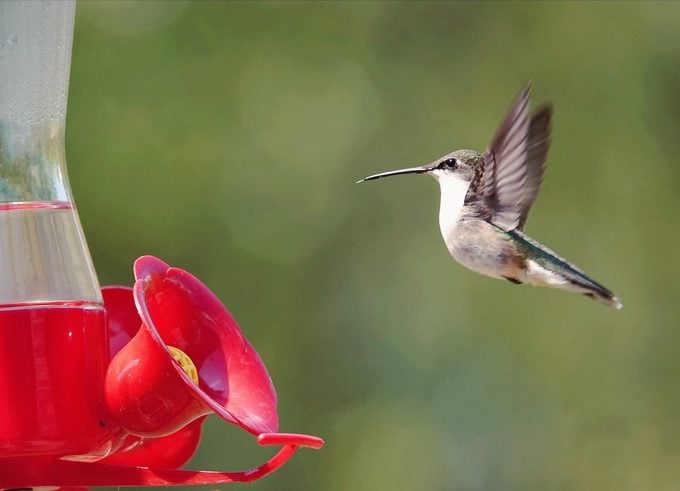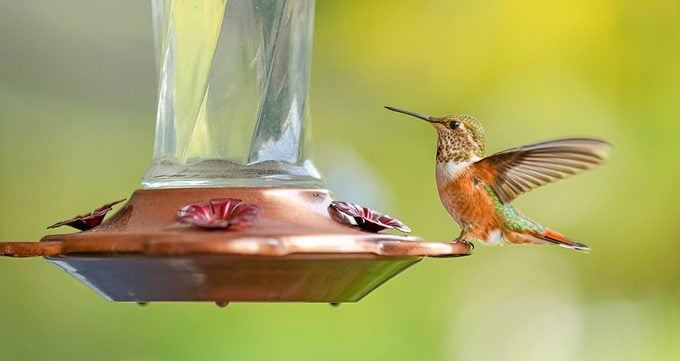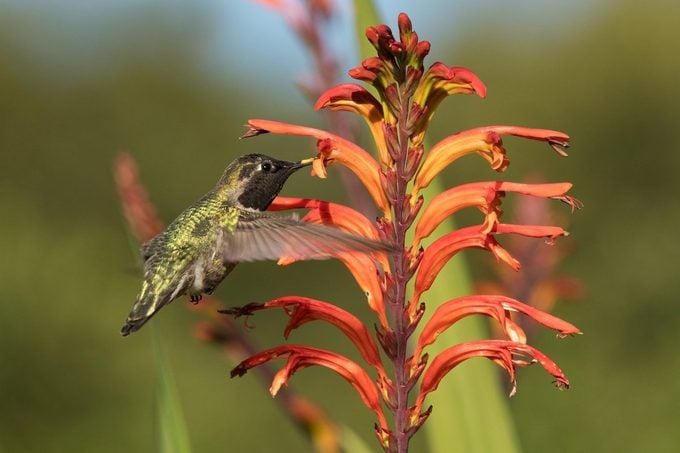The Only Homemade Hummingbird Nectar Recipe You Need
Updated: Jan. 04, 2024
Wondering how to make hummingbird nectar to fill your feeders? Get the simple DIY recipe for homemade hummingbird nectar.
No fliers are as well-equipped to extract nectar as hummingbirds. With long, thin bills and tongues that lick up to 13 times a second, their mouths alone make them impressive. Commercial hummingbird nectar is convenient, but you can easily DIY! Here’s how to make your own homemade hummingbird nectar recipe.
On This Page
Hummingbird Nectar Recipe

- Combine a ratio of 4 parts water to 1 part table sugar
- Bring the water to a boil to break down the sugar completely
- Once the mixture is cool, fill feeders
- Refrigerate what you don’t use between fillings
Pure white table sugar is the safest option for for DIY hummingbird nectar. Avoid brown sugar, honey or artificial sweeteners. Many also consider organic sugar, which doesn’t tend to be fully refined to pure sucrose, unsafe for feeding hummingbirds. And skip the red food dye in your hummingbird mixture! The birds don’t need it, and it’s easier to monitor the freshness of colorless sugar water.
How Often Should You Change Hummingbird Nectar?

You can avoid moldy hummingbird nectar by filling feeders only halfway and cleaning them before each refill. Birding experts Kenn and Kimberly Kaufman say, “According to lab studies, the amount of sugar water consumed by a hummingbird will vary depending on the richness of the sugar concentration. With the typical 4:1 ratio of water to sugar, a ruby-throated hummingbird probably won’t drink more than about 2 fluid ounces per day.”
Placing your feeders in the shade will help to keep your homemade nectar from spoiling too quickly. Change out the mixture every three to five days—and more frequently on hot days. If feeders are empty, the birds will look for food elsewhere.
“Hummingbirds’ needs regarding nectar are so specific and quite regular, so they’ll always take advantage of those kinds of resources,” explains John Rowden, senior director for bird-friendly communities at the National Audubon Society.
Foil territorial nectar hogs by putting up several hummingbird feeders out of sight from one another.
When should you put out hummingbird feeders in spring?
Plant Nectar Flowers for Hummingbirds

Another hummingbird nectar source comes from your garden! John notes that feeders should ideally be used in addition to native plants to help fulfill a hummingbird’s nutritional needs.
Hummingbirds feed on flower nectar as well as homemade nectar. To attract hummingbirds regardless of your location, plant nectar-rich, tube-shaped flowers and fill your feeders.
Some top plant choices include bee balm, salvia and hummingbird mint. Also try growing these red flowers that hummingbirds love.
“I plant peas on trellises between my nectar feeders. This seems to deter hummingbirds from claiming the feeders as their own and bullying others, because it helps prevent visual contact among the birds—and the pea blossoms provide an additional nectar source,” says Birds & Blooms reader Jim Low.
Note: Make sure you skip the pesticides on your hummingbird nectar flowers. These tiny birds also eat plenty of insects for protein and feed them to their young.
Next, learn how to create an ideal hummingbird habitat.
Sources:
- National Audubon Society
- Kenn and Kimberly Kaufman




















